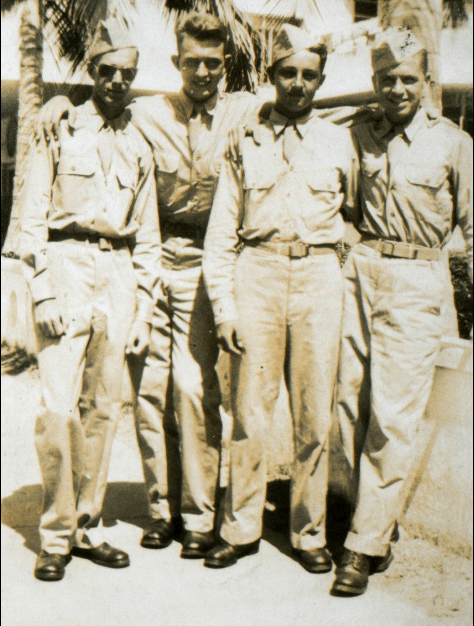Seventy five years ago on January 10, 1945 WWII 8th AF Veteran and Long Time Volunteer Sam Najarian’s plane was shot down.
Sam Najarian was born in Brooklyn, New York and volunteered for the Army Air Corps cadet program while still in high school in 1943. He was deferred until graduation and left for training a few weeks later. He reported to Fort Dix, N.J., and was sent to Miami for basic training. He was eighteen years old.

Sam trained as a B-17 navigator and was assigned in 1944 to the 364th BS 305th BG at Chelveston Airfield, England.
His first mission was to strike an oil refinery in Germany. “That was tough, tough,” said Najarian, “but I didn’t know it then.” The missions got harder, rather than easier, as he accumulated them, he said.
On his thirteenth mission on January 10, 1945, Sam’s crew flew to Gymnich near Cologne. Sam’s plane suffered an engine loss on the way to and from the target. With only two engines, heavy flak damage and a wing on fire, the pilot gave the bail out order. Sam was an avid newspaper reader. That morning he read about the Battle of the Bulge raging on below. He convinced the pilot to rescind the order, believing they could fly the plane over Allied occupied territory making bailing out a less dangerous action. He navigated the plane west and hoped they had traveled far enough to reach friendly territory before notifying the pilot. As Sam put it, there is no line on the ground telling you where the enemy is. As the pilot rang the bail out bell, Sam and the bombardier prepared to bail out of the nose hatch. But there was a problem. Sam enjoyed coffee. The coffee and the cold made him need to “pass water” frequently. He kept a large can next to him and used it when needed. In the turmoil of the mission the filled can had tipped over, unfrozen, spilled and then refrozen—right over the front nose hatch. They were frozen in. Both men kicked at the frozen door to no avail. It finally dawned on one of them (Sam could never remember which) that there were other bail out hatches in the plane and the two crewmen jumped out to safety. Sam remembered being so scared that instead of counting to ten he counted, one, two, ten and pulled the cord.
Unfortunately two of the nine crew members did not survive their bail out. Sam came down near a farmhouse. He hid in the barn, but an elderly woman, “close to 90,” came in, and he had to make a decision. He stood up and waved a small American flag, and the woman rushed over, grabbed him under the armpits and lifted him off the ground. “My feet didn’t come back down for a good 20 seconds,” he said. “She took me to the farmhouse. They broke out some wine and cheese, and we started a celebration.” The bombardier eventually ended up in the same Belgian farmhouse a few hours later. The Germans had retreated only two days before and they were the first Americans the farm family had met. Sam and the bombardier returned to England to fly missions after R and R in Scotland. Sam completed 26 missions in the Eighth before the war in Europe ended. Sam returned home to his life in New York and took a series of small jobs. He eventually earned an engineering degree from City College of New York, worked at a consulting company, and raised a family in Connecticut. After retirement, Sam moved to South Carolina with his wife Helga. They have two children.

Sam credited that frozen door with saving the duo’s lives. It forced them to stay in the plane longer which meant the plane traveled farther into Allied territory. Unfortunately two of the nine crew members did not survive their bail out. One never opened his chute and one (the first crew member out of the plane) landed in German territory and was shot.
Sam passed away in 2012. He volunteered at the museum’s Mission Experience every Saturday afternoon guiding visitors through the three part movie and told them his experiences during WWII. He is sorely missed. He was a great man and friend.
Written by Heather Thies, Director of Education
